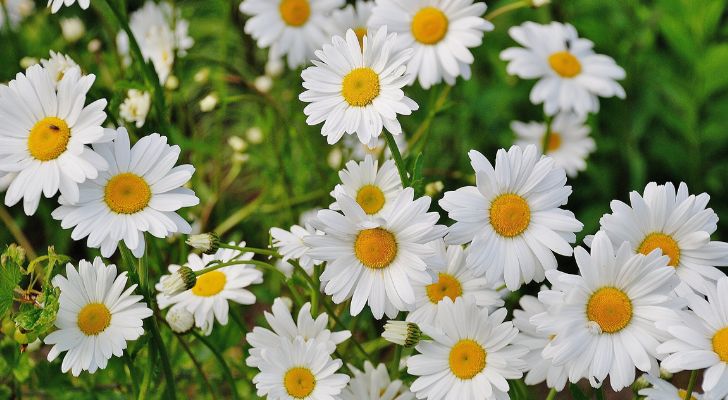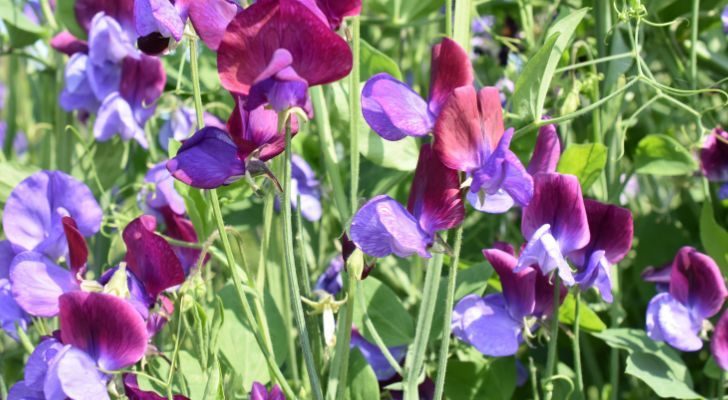Babies born in April are blessed with two birth flowers: delightful daisies and fragrant sweet peas.
Daisies are everywhere, popping up along roadsides, in fields, and gardens. Who can resist playing the classic “he loves me, he loves me not” game with these flowers?
Sweet peas’ colorful petals cluster at the ends of long stems, filling the air with the delightful scent of spring.
Whether as decorations or gifts, daisies and sweet peas bring floral magic to April birthdays. Plus, impressing your guests with these remarkable facts about April’s birth flowers is a fun party trick.
10 Facts About Daisies

Technically, a daisy flower head is not just one flower but actually two in one. The central cluster, called the disc floret, is distinct from the surrounding petals, which is called the ray.
Daisies are safe to eat and can be used as garnish or incorporated into salads or soups. The raw leaves can also be eaten, but they could leave a bitter taste in your mouth.
You’re not wrong if you think daisies look like miniature sunflowers. Both flowers belong to the same large family called Asteraceae.
Daisies are tough plants capable of adapting to different habitats. As a result, they flourish everywhere on the globe except Antarctica.
On April 18, 2009, 331 people gathered on an Italian TV show to play the world’s largest game of “He Loves Me, He Loves Me Not” with daisies.
This flower gets its name “daisy” from the Old English term daes eag, meaning “day’s eye.” This comes from its behavior of shutting its petals at night and unwrapping them in the morning.
Bees love daisies, so you’re likely to find them buzzing around fields of this flower. The flat arrangement of daisy petals makes it easy for the bees to access the pollen they use for food.
Daisies were traditionally used to make herbal medicines for colds. Modern studies have revealed that these humble plants contain almost as much vitamin C as lemons, which could help fight a cold.
Over 20,000 daisy species exist, and they come in various colors, including pink, yellow, white, and blue.
Daisies are the official flowers of the fifth wedding anniversary. They’re also said to represent purity and innocence.
10 Facts About Sweet Peas

Sweet peas enrich the land they grow in. They possess the unique ability to grab nitrogen from the air and infuse it into the soil in a form that plants can use.
Don’t be misled by the name; sweet peas differ greatly from edible peas and should never be eaten. The seeds of this plant contain toxins, making it unsuitable for human or animal consumption.
Sweet peas are resilient once established, and just cutting down the plant won’t eliminate these flowers. You could wake one day to find a new shoot blooming in your garden as it spreads underground via rhizomes.
Keep your sweet peas far from fruit like apples, bananas, and tomatoes that produce ethylene when ripening. Sweet peas are sensitive to ethylene, which can cause their petals to wilt and delay flowering.
Sweet peas are powerfully scented; a bouquet of these can make your house smell divine. Their scent is like a honeysuckle, jasmine, and lilac mix with citrus, amber, or sandalwood notes.
Cold climates are no match for the tenacious sweet pea. This flower isn’t afraid of the cold and can thrive in temperatures of 23°F (-5°C) with proper care.
Sicily, Italy, is the original home of sweet peas, first identified in the 17th century. In Latin, they are called the fragrant pea, Lathyrus odoratus.
Henry Eckford, a horticulturist from Scotland, bred the modern sweet peas in the 19th century. His new creations were renowned for their robust fragrance, making them extremely popular.
Sweet peas, often used in weddings, are romantic flowers believed to symbolize youthful love. You can also give this flower to friends to appreciate their devotion.
With their long stems and climbing nature, sweet peas can grow incredibly tall in the right conditions, reaching 8 feet (2.4 meters).
April’s birth flowers may look nothing alike, but they share one common feature: their resilience.
No matter where they’re planted, these daisies and sweet peas can adapt and flourish, just like April babies.
There’s no better way to appreciate the strength of those born in April than a gift of daisies and sweet peas.


















